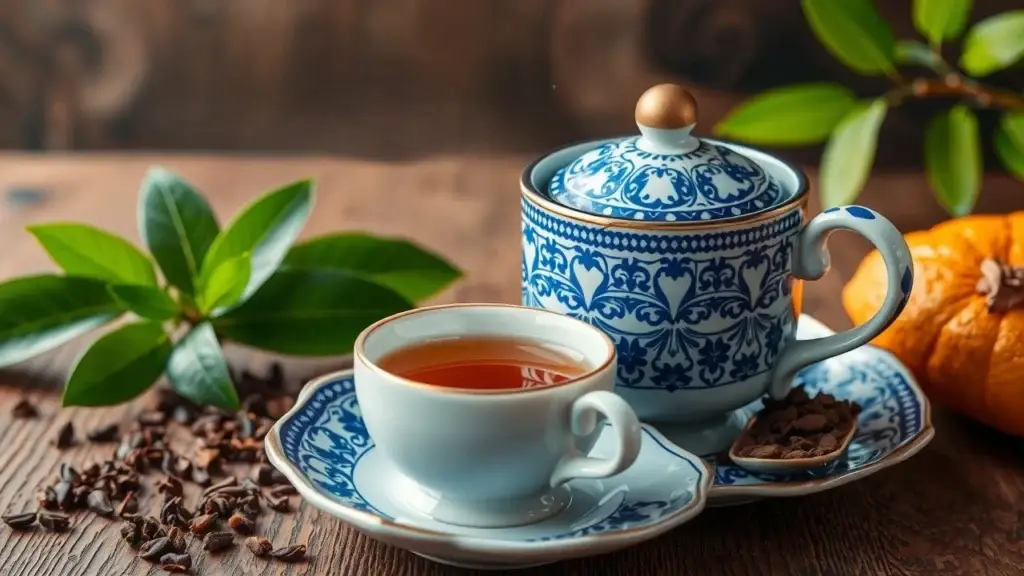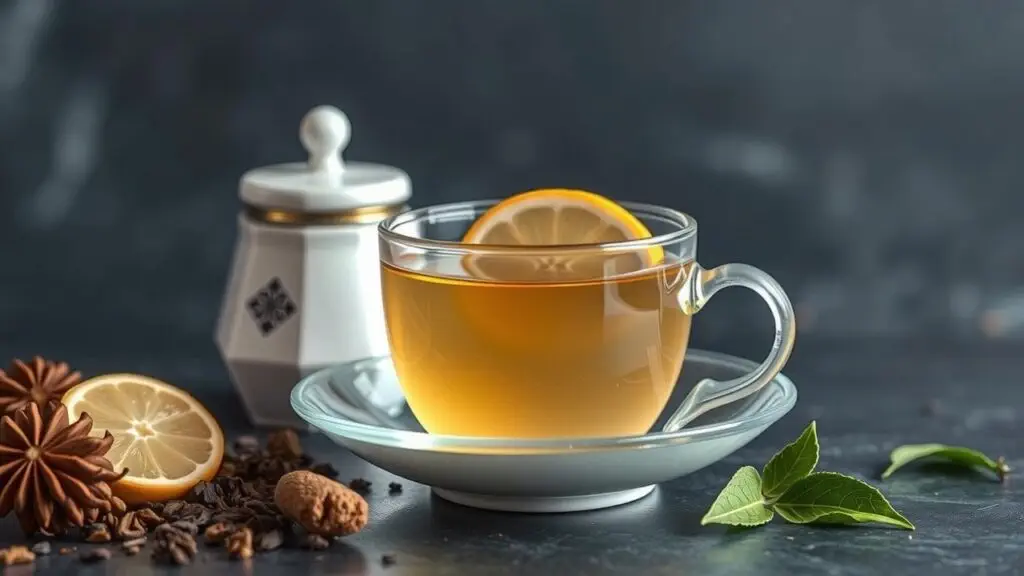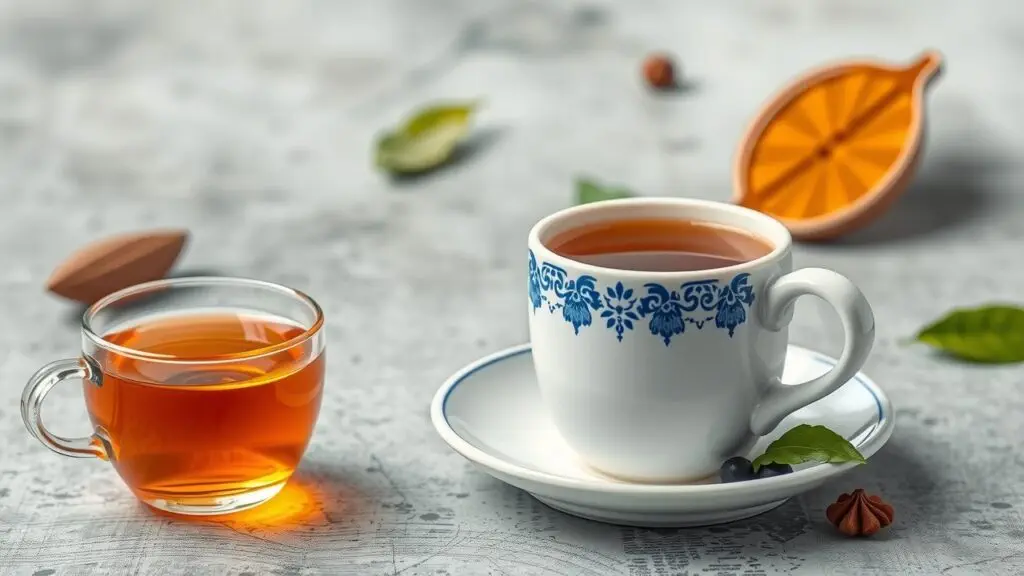Explore the diverse types of Indian tea, from classic black teas to the spiced delight of masala chai. This guide covers popular varieties, the rich history of Indian tea culture, and production methods across different regions.
What is Indian tea?

Indian tea includes a wide range of tea types produced in India. These teas are known for their strong flavors and unique characteristics. The main types of Indian tea are black tea, green tea, white tea, oolong tea, and herbal teas. Each type has special qualities based on how it’s made and where it grows.
- Black Tea: This is the most popular type of Indian tea. It’s fully oxidized, giving it a bold flavor and dark color. Assam and Darjeeling are famous for their black teas.
- Green Tea: This type isn’t oxidized at all. It keeps its green color and has a lighter taste with fresh, grassy notes. The Nilgiri region is known for its good green teas.
- White Tea: This is a very delicate tea made from young leaves and buds. It’s lightly processed, giving it a sweet or floral taste.
- Oolong Tea: Oolong is partly oxidized, so its flavor can be a mix of black and green teas.
- Herbal Tea: Herbal teas aren’t made from the Camellia sinensis plant. Instead, they use various herbs, spices, or flowers to create tasty drinks.
Brief history and cultural significance of tea in India
Tea has been important in India for many years. It was first brought by British colonists in the 19th century as part of their trade efforts. Soon after, Indians from all walks of life began to love it.
Key states related to this industry include:
- Assam (AS): Known for strong black teas with malty flavors.
- West Bengal (WB): Home to Darjeeling’s famous high-altitude gardens that produce fragrant black teas.
- Sikkim (SK): A smaller but growing area recognized for organic farming practices.
Drinking tea became a big part of everyday life. Chai stalls offer spiced milk-tea mixes called masala chai throughout cities and villages.
Overview of major types of Indian teas
India has several unique types of tea with different regional flavors:
| Type | Characteristics | Popular Regions |
|---|---|---|
| Black | Strong flavor; fully oxidized | Assam & Darjeeling |
| Green | Light taste; unoxidized | Nilgiri |
| White | Delicate; minimal processing | Himachal Pradesh |
| Oolong | Semi-oxidized; complex flavors | Karnataka |
| Herbal | Infusions using various plants | Nationwide |
These types show how local conditions shape each cup’s taste—altitude changes aroma while soil affects flavor—making each sip special to its place in India’s diverse lands.
Major Regional Varieties of Indian Tea
Assam Tea: Characteristics and Flavor Profile
Assam tea is a well-loved type of Indian tea. It’s famous for its strong flavor and full-bodied strength. This black tea grows in the rich valleys of Assam. One of its standout features is its malty flavor, which makes it perfect for breakfast blends. The warm climate and fertile soil help create this bold taste. Many people enjoy Assam tea with milk, making it a great choice for chai or other milk-based recipes.
Darjeeling Tea: The “Champagne of Teas”
Darjeeling tea is often called the “Champagne of Teas.” It comes from high-altitude plantations in West Bengal. This unique terroir shapes its flavor, which changes with each harvest season, known as flushes. The first flush has light, floral notes. The second flush is famous for its muscatel flavors. Autumnal flush teas offer a smoother taste but still keep some complexity. People who love tea really seek out Darjeeling for its delicate aromas.
Nilgiri Tea: A Southern Gem
Nilgiri tea hails from Tamil Nadu in southern India. It’s known for bright flavors and brisk citrusy undertones. This variety thrives at higher elevations where cooler temperatures boost its refreshing taste. Nilgiri teas are versatile too! They can be enjoyed hot or cold, making them perfect for iced teas during the summer months.
Kangra Valley Tea: An Emerging Contender
Kangra Valley tea comes from Himachal Pradesh. It uses traditional processing methods that highlight its quality. This emerging contender stands out with its floral aroma and mild astringency. More people are starting to discover Kangra’s unique offerings as awareness grows about this delightful brew that reflects its mountain origins.
These major regional varieties show the amazing diversity within types of Indian tea. Each one offers something unique that reflects their growing environments, making them special to tea lovers everywhere.
Types Based on Processing Methods
Black Tea from India Explained
Black tea is super popular in India. It’s known for its strong flavor and rich smell. This type of tea goes through a full oxidation process. That’s what gives it a dark color and bold taste. In India, the main ways to process black tea are CTC (Crush, Tear, Curl) and orthodox.
- CTC tea: Used in many blends, it’s fast to brew.
- Orthodox tea: Hand-processed and has more complex flavors.
Assam tea is famous for being malty and bold. It’s perfect for breakfast! Darjeeling tea is lighter with floral notes, often called the “Champagne of Teas.” Nilgiri tea smells great and has fruity hints, making it nice hot or iced.
How Black Tea is Processed?
Black tea goes through several steps:
- Withering: Leaves lose moisture after being spread out.
- Rolling: Leaves are rolled to break down cell walls. This releases oils.
- Oxidation: Enzymes react with oxygen here, making leaves darker.
- Drying: Heat stops oxidation when it’s just right.
- Sorting: Dried leaves get sorted by size and quality.
These steps create different types of Indian black teas that suit various tastes.
Popular Varieties of Black Tea
India has many famous black tea varieties:
- Assam Tea: Grown in Assam’s valleys; it has a brisk taste and deep amber color.
- Darjeeling Tea: Grown in the Himalayas; known for its light floral flavor.
- Nilgiri Tea: Comes from southern India; recognized for its bright liquor and scent.
- Kangra Valley Tea: From Himachal Pradesh; has unique flavors from high-altitude growing.
These types show how India’s climate affects the flavors in black teas.
Green Tea from India Explained
Green tea is different because it’s not fully oxidized during processing. In India, green teas are popular for their health perks and tasty profiles. One example is Kashmiri Kahwa, a spiced green brew with nuts or saffron. Other regional variations use local ingredients too!
Minimal Oxidation Process
The minimal oxidation process keeps many antioxidants in fresh leaves. This makes colors range from pale yellow-green to deeper shades, depending on how it’s made, like steaming or pan-firing.
Health benefits of green teas include better metabolism support thanks to catechins found in these drinks. Drinking green tea regularly may help heart health as well!
Examples of Regional Green Teas
Different regions produce unique green teas:
- Sikkim Green Teas: These have smooth textures with subtle plant-like notes that reflect the local soil.
- Assam Green Teas: These offer stronger grassy flavors due to local climate conditions that impact how they’re grown.
Understanding these types helps you appreciate what makes each variety special!
White and Oolong Teas Produced in India

Does India produce white or oolong teas?
India is famous for its black and green teas. However, it also produces some special types like white and oolong teas. While these are not as common, they have unique flavors that many tea lovers enjoy.
White Teas
One well-known white tea from India is Silver Needle. This tea is rare and highly valued for its delicate taste. Silver Needle is made from young buds picked by hand at a specific time of year. This careful process results in a light, sweet flavor with hints of flowers. The leaves undergo minimal oxidation, which keeps their natural qualities intact.
Apart from Silver Needle, there are other regional white teas made in India. Some tea gardens in Darjeeling create limited batches of white tea using traditional methods similar to those used for their popular black teas. These different styles may use various tea plants or processing methods that add unique flavors while still representing the range of Indian tea varieties.
Oolong Teas
Oolong tea is not produced as much in India compared to countries like China or Taiwan. One reason is that oolong needs special growing conditions, like cooler temperatures found at higher altitudes. This can be tough to find in India’s varied landscape since most farms focus on black and green teas.
But there’s a chance for growth in India’s oolong market! As more people seek out different flavors and health benefits linked to various types of Indian teas, farmers may look into producing organic Indian teas, including oolong. Sustainable farming practices could help them grow oolong alongside existing crops without harming quality or yield.
As interest grows in these unique options from India’s rich agricultural land, we might see more high-quality oolong teas enjoyed both locally and internationally.
Masala Chai and Other Spiced Tea Beverages
Masala chai is a popular Indian tea. It mixes strong black tea with a variety of spices, creating a warm and flavorful drink. This tea brings comfort and joy to many, whether you’re just starting your tea journey or you’re a seasoned pro.
How is Masala Chai made?
Making masala chai is simple. Here’s a traditional recipe that uses spices like cardamom and ginger:
- Ingredients:
- 2 cups water
- 1-2 teaspoons loose black tea (like Assam)
- 1 cup milk (or more for creaminess)
- 1-2 tablespoons sugar (to taste)
- Spices: 2-3 crushed green cardamom pods, a small piece of fresh ginger (grated), and optional cinnamon stick.
- Boil Water: Start by boiling the water in a saucepan over medium heat.
- Add Tea and Spices: Once the water boils, add the loose black tea along with the crushed cardamom and grated ginger. Let this simmer for about five minutes to mix the flavors.
- Incorporate Milk: Pour in the milk based on how creamy you want it. Let it boil again gently.
- Sweeten It Up: Add sugar according to your taste, then let it simmer for another minute or two.
- Strain and Serve: Strain the masala chai into cups using a fine mesh strainer to remove solids before enjoying it hot.
Different regions may have their own unique ways to prepare masala chai, sometimes using other spices or even ingredients like vanilla or nutmeg based on local tastes.
Other Spiced Teas
India has many other spiced teas that reflect its rich culture:
- Noon Chai from Kashmir is famous for its pink color. This color comes from special processing techniques that use baking soda during cooking. It’s often topped with nuts for added flavor.
- Irani Chai, which is enjoyed in Hyderabad, has evaporated milk added to it along with spices like cardamom. Some even use sweetened condensed milk for extra richness.
- Tulsi Tea stands out because it’s made with holy basil leaves instead of regular black tea leaves. This tea offers health benefits too, along with flavors enhanced by herbs like mint or lemongrass depending on what you like.
These regional teas show how diverse spiced teas can be while still keeping the warmth and tradition found in masala chai.
Brewing Guide: Achieving the Perfect Cup
Brewing Indian tea is fun and can make your tea experience much better. Knowing how to brew different types of Indian tea will help you get a great cup every time.
Water Temperature Guidelines for Different Tea Types
Water temperature is super important for brewing tea. It affects how flavors come out. Here are some simple rules to follow:
- Black Tea (like Assam): Use boiling water, around 200°F to 212°F (93°C to 100°C). This hot water brings out strong flavors.
- Green Tea (like Nilgiri): Brew it with water between 160°F and 180°F (71°C to 82°C). This keeps it from tasting bitter while still getting nice flavors.
- White Tea: Brew at about 160°F to 185°F (71°C to 85°C) so the soft notes are clear without being too strong.
- Oolong Tea: Best brewed at 190°F to 205°F (88°C to 96°C), depending on if it’s light or dark oolong.
Steeping Times for Optimal Flavor Extraction
How long you steep your tea really matters for taste:
- Black Tea: Steep for about 3–5 minutes. If you steep it longer, it might taste bitter.
- Green Tea: Aim for about 2–3 minutes. This keeps its fresh flavor.
- White Tea: Steep gently for around 4–5 minutes so the flavor develops without being too strong.
- Oolong Tea: Depending on how it’s made, steep for about 4–7 minutes, adjusting based on what you like.
Tea-to-Water Ratio Adjustments for Desired Strength
Finding the right mix of tea leaves and water is key:
For loose leaf teas:
- Use about one teaspoon per cup (8 oz) for normal strength.
- If you want a stronger brew, use one-and-a-half teaspoons per cup for richer flavors.
It’s all about what you like! Try different amounts to see what works best for you.
Essential Brewing Equipment
Having the right tools makes a big difference when brewing tea:
- Kettle: An electric kettle with temperature settings helps heat water just right.
- Teapot: Pick one made from materials like ceramic or glass that keep heat in and let you see the brew.
- Infuser: A fine mesh infuser or basket is great for even brewing and easy removal after steeping, especially with loose leaf.
These tools help you brew better and enjoy your tea more!
Tips for Storing Tea To Maintain Freshness
To keep your tea fresh longer, here are some easy tips:
- Store tea in an airtight container, away from light, moisture, and strong smells that can ruin its taste.
- Keep it in a cool place; this helps keep the aroma and flavor intact.
Following these tips will help you appreciate all the unique flavors of Indian teas!
Health Benefits and Choosing Your Tea

Overview of Potential Health Benefits Associated with Different Types of Indian Tea
Indian teas, like black and green varieties, offer many health benefits. They are full of antioxidants that help fight stress in the body. Antioxidants can reduce swelling and lower the chances of serious diseases, such as heart disease and cancer.
Black tea can help improve heart health. It may lower cholesterol levels and help blood vessels work better. A study in the American Journal of Clinical Nutrition shows that drinking black tea regularly might reduce heart problems thanks to its flavonoid content.
Green tea is also famous for its weight loss benefits. Research says it can boost metabolism and help burn fat during workouts. Plus, green tea has catechins, which are strong antioxidants linked to better brain function and a lower risk of diseases like Alzheimer’s.
Herbal infusions have unique benefits too, depending on what they contain. For example, chamomile is great for relaxation, while ginger tea can support digestion.
Guide for Choosing the Right Indian Tea Based on Flavor Preferences
Choosing an Indian tea can be fun! Think about what flavors you like—strong or delicate? Assam tea is known for its bold malty flavor, making it a good choice for a morning boost when you need caffeine. On the flip side, Darjeeling tea has lighter floral notes, perfect for sipping in the afternoon or winding down in the evening.
If you want something refreshing yet calming after dinner, Nilgiri teas might be a great pick with their pleasant aroma and smooth taste.
Here’s a quick guide:
- Morning Energizers: Assam (strong)
- Afternoon Delights: Darjeeling (floral)
- Evening Relaxers: Nilgiri (smooth)
Picking your favorite type not only enhances your enjoyment but also matches how you want to feel throughout the day.
Considerations for Buying High-Quality Indian Tea
When you shop for high-quality Indian tea, keep these tips in mind:
- Certifications: Look for marks like Geographical Indications (GI), which show authenticity from specific regions.
- Freshness Dates: Check packaging dates; fresher teas usually taste better.
- Packaging Quality: Good packaging keeps out moisture and light that can ruin flavor.
- Organic Options: If possible, go for organic brands; they often have higher standards on pesticides.
To find real quality products online or in stores, focus on specialty shops that sell organic or fair trade options rather than regular grocery store brands.
By understanding these details about different types of Indian tea—like their health benefits and how to choose—you’ll be ready to enjoy each cup fully!
FAQs About Indian Tea
What are the different types of Indian tea?
Indian tea includes black, green, white, oolong, and herbal teas. Each type has its unique flavor and characteristics.
What is the health benefit of Indian tea?
Indian tea offers antioxidants that help fight stress. Black and green teas support heart health and metabolism.
How do regional climates affect Indian tea flavors?
Regions like Assam and Darjeeling produce distinct flavors due to climate and soil conditions. Higher altitudes yield floral notes in tea.
What is Masala Chai?
Masala chai blends strong black tea with spices. Common spices include ginger, cardamom, and cinnamon. It’s a comforting drink enjoyed across India.
Where can I buy high-quality Indian tea?
You can find quality Indian tea online at retailers like Amazon or specialty shops like Tea Trunk. Local stores also offer unique selections.
Unique Insights on Indian Tea
- Tea Cultivation: Tea grows in specific regions of India like Assam, Darjeeling, and Nilgiri. Each area has distinct climate features.
- Tea Processing Methods: Black teas undergo oxidation while green teas are minimally processed. Oolong teas have partial oxidation for complex flavors.
- Types of Tea Packaging: Quality packaging keeps out light and moisture. This helps preserve flavor and freshness over time.
- Tea Flavor Profiles: Each type of tea has different flavor notes, such as malty Assam or floral Darjeeling. The terroir influences these flavors significantly.
- Traditional Indian Teas: Popular varieties include Noon Chai from Kashmir and Irani Chai from Hyderabad. These teas reflect regional traditions and tastes.
- Sustainable Tea Production: Many brands focus on organic farming practices. Sustainable production methods ensure the environment remains healthy.
- Caffeine Content in Tea: Different types of Indian tea contain varying caffeine levels. Black teas generally have more caffeine than green or white teas.
- Tea Ceremonies: Tea ceremonies highlight the cultural significance of tea drinking in India. They showcase various preparation methods and flavors enjoyed throughout the country.
These insights enhance your understanding of types of Indian tea while connecting to rich cultural traditions surrounding this beloved beverage.
Related Topics
- Types of Masala Chai
- Types of Indian Tea Processing Methods
- Types of Black Tea
- Types of Green Tea
- Types of Herbal Tea
- Types of Spiced Tea Beverages
- Types of Regional Indian Teas
- Types of Tea Packaging
- Types of Tea Brewing Equipment



Types of Indian Tea: A Guide to Black Tea, Masala Chai, and More